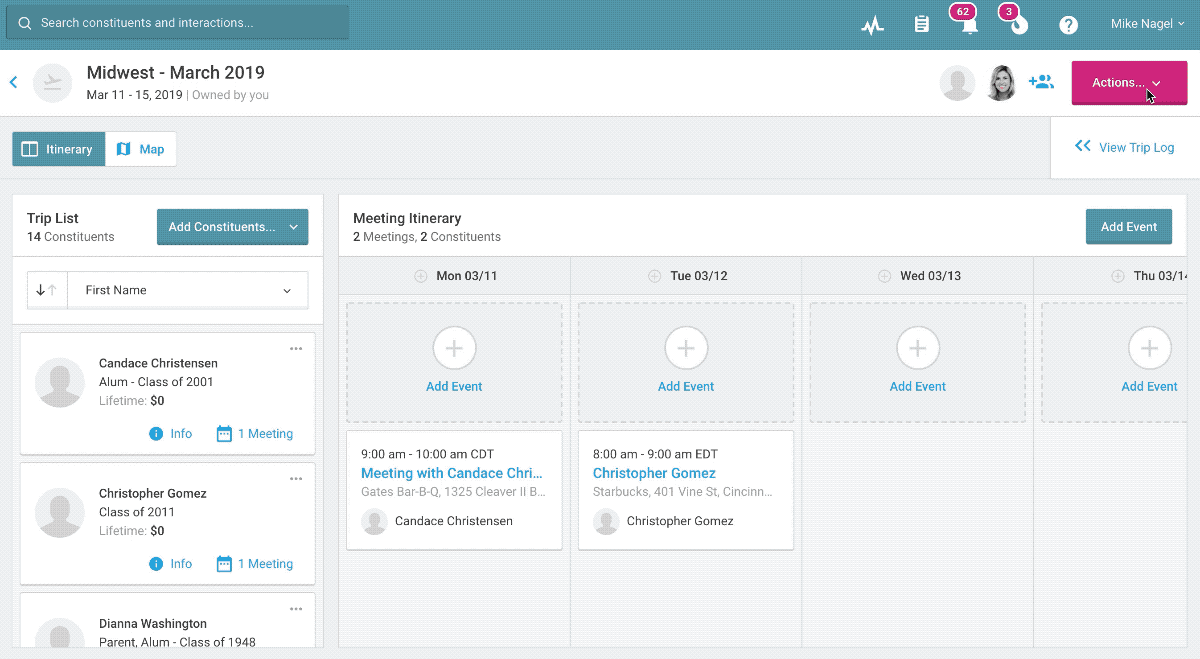With the dog days of summer around the corner, the office is a little quiet and the inbox doesn’t fill up quite as quickly. It’s a great time to step back and tackle some bigger issues that are usually on the back burner.
First up, some tips for everyone out there who managers gift officers.
Travel is part of the gift officer life. It’s where the rubber meets the road, literally and figuratively. But it’s also very expensive. Like, very expensive. Like, sometimes-makes-managers-queasy expensive.
But it’s not going anywhere anytime soon.
So we need to work on making it as efficient and effective as possible.
With travel season beginning again this fall, your gift officers are probably starting to think about trips already. Before planning gets too serious, take the summer as a chance to rethink the strategy and take a new approach to review trip planning for your team.
We really like the rule of two approach. We learned all about it from Susan Armacost, Executive Director for University Development at the University of Memphis. And if you stick to it, your gift officers will end up taking trips that set them up for success and make the most of your resources. Which is basically like having cake and eating it, too.
Here’s how it works.
Two Months in Advance
A couple months ahead of traveling is time for the trip proposal. Maybe your gift officer has one or two incredibly promising prospects who are in close proximity to one another. Great. That’s a perfect place to start.
Now you’ve got to build the trip from there.
That’s where prospect rating becomes incredibly valuable. It lets both the gift officer and manager gauge the capacity level of potential prospects in the area. A great rating won’t guarantee a gift, of course, but it’s a great indicator that an in-person visit will be worth the cost of admission, even if it’s just to establish a relationship.
Once the broad strokes of a trip are agreed upon, the planning stage is about two things: Quality and quantity. Most times in life, you can’t have both. But major gift travel has to be one of the rare exceptions. In order for a trip to be worthwhile, a gift officer must visit prospects with a high capacity to give, and visit a lot of them.
Which brings us to the next part of the rule…
Two Visits (Minimum!) Per Day
Those anchor visits will give you the outlines of the trip, so they’re a great place to start. But there’s still a lot of room to fill it out. According to Susan’s philosophy, if a gift officer isn’t seeing a minimum of two prospects a day, the trip isn’t worth the money. Ideally, she’d prefer three or four meetings a day, but given logistics, locations and availability, two is the bare minimum for each day a gift officer will be on the road.
Prospect scoring comes in handy again at this stage. If the destination your gift officer has in mind is only home to a few top-tier prospects, that doesn’t necessarily mean it’s not worth the trip. Those prospects certainly deserve a personal visit, but using up a big chunk of resources for just a few meetings isn’t wise. So fill out the margins with prospects just a tier or two below those main visits. They might not be capable of a gift that’s as robust, but they’re well worth meeting with.
Pull up prospect scoring and go down your tiers until there are a minimum of two visits a day. And if someone cancels a meeting (which every gift officer knows is inevitable), EverTrue has location searches to find last-minute filler visits nearby.
Two Weeks in Advance
This is when all the details of the trip should be set in stone. The itinerary should be fully fleshed out two weeks before the gift officer is set to depart. Susan always sets up a meeting two weeks before the trip to run through the itinerary one last time.
She looks through the whole plan, including all the details of contact with prospects leading up to the trip. If contact has been insufficient and the trip doesn’t meet the two-meetings-a-day rule, she pulls the plug. Simple as that.

By establishing clear standards for what a successful trip looks like well in advance, there’s no wiggle room on whether or not the trip gets the green light. It’s either a good use of the school’s money and her staff’s time or it’s not. There’s no gray area to navigate because the rules are well established.
This isn’t the only thing managers of gift officers can do this summer. Check back on Monday for the next installment of our Summer Checklist.
